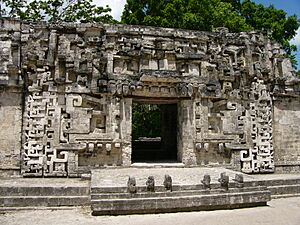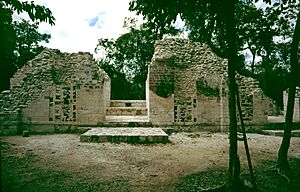Chicanná facts for kids
| Location | Becán, Rio Bec, Mexico |
|---|---|
| Region | Rio Bec |
| History | |
| Abandoned | 1100 A.D. |
| Events | Conquered by: Maya Civilization |
| Site notes | |
| Archaeologists | Jack D. Eaton |
| Architecture | |
| Architectural styles | Buildings |
Chicanná was an ancient Maya city. It was built during the Classic period, from about 600 A.D. to 830 A.D. The city's name comes from its most famous building, Structure II. In the Mayan language, Chicanná means "House of the Serpent Mouth." This is because chi means "mouth," can means "serpent," and na means "house."
You can find Chicanná in the Mexican state of Campeche. It is on the Yucatán peninsula, about two kilometers west of another Maya site called Becán. Chicanná is one of many ancient ruins in this area.
People lived in Chicanná from around 300 B.C. to 1100 A.D. The city was likely at its busiest between 300 B.C. and 250 A.D. Chicanná might have relied on Becán for many things, as Becán was a larger, self-sufficient city. Chicanná is special because it mixes different building styles. You can see features from the Río Bec, Chenes (Mayan city), and even the Puuc styles.
Unlike some Maya cities, Chicanná does not have huge pyramids. Instead, its buildings are smaller but very detailed and beautifully decorated. This suggests that Chicanná was a home for important people, perhaps the leaders of the region. The city is known for its well-preserved doorways with amazing carvings. It was a place for important spiritual ceremonies and rituals.
Contents
Discovering Chicanná
When Was Chicanná Found?
Chicanná is located in the state of Campeche, Mexico. It is part of the ancient Maya Rio Bec region. An explorer named Jack Eaton first studied the site in 1966. He was exploring the Yucatán area at the time.
What Was Found at Chicanná?
The most famous building at Chicanná is Structure II. It was studied more closely during excavations in 1970. The main part of Chicanná has seven buildings. Structures I, II, and III form the Main Plaza. Four other buildings are located around this main area.
Structures I and II are the most well-known. Both are temples in the main plaza. Experts believe they were built to align with the sun's movements. This would have helped the Maya keep track of their calendar.
How Old Are the Buildings?
Scientists used radiocarbon dating on charcoal and other materials found at the site. This showed that Structures I and II were built during the Late Classic period. Chicanná was built in several stages over time. Structure XI was likely built first. This was determined by studying the types of pottery found there. Pottery analysis also supports the idea that Structures I and II were built later.
Important Buildings at Chicanná
Structure I: A Temple in the Plaza
Structure I is a temple located in the main plaza. It has four carved panels in the Rio Bec style. The Rio Bec style is known for temple pyramids in the central Maya lowlands. Unlike other Maya styles, Rio Bec buildings are often spread out more. This makes the city layout less crowded.
Other Maya sites with the Rio Bec style include Becán and Xpuhil. Both are very close to Chicanná. Because of their location and similar building styles, it is thought that these cities traded and connected with Chicanná. Structure I has six rooms in total. It also has five steps leading inward towards the plaza.
Structure II: The Serpent Mouth Building
Structure II is a smaller building, but it is the most famous at Chicanná. It has a very well-preserved carving of a serpent. The name of the site, Chicanná, comes from this serpent carving on Structure II.
Structure II has eight rooms. Inside each room, the plaster walls have paintings. These paintings show animals, monsters, clothing, and other buildings. They give us a glimpse into the Maya world.
Images for kids
See also
 In Spanish: Chicanná para niños
In Spanish: Chicanná para niños





